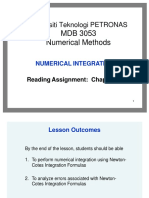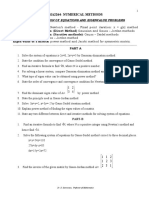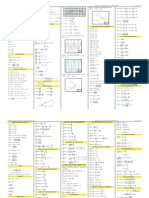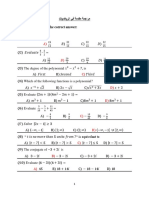Mzumbe University Falculty of Science and Technology MSS 224:numerical Analysis Tutorial Sheet 4
Uploaded by
Melchizedek MashamboMzumbe University Falculty of Science and Technology MSS 224:numerical Analysis Tutorial Sheet 4
Uploaded by
Melchizedek MashamboMSS 224 SEM 2 2016/2017 1
Mzumbe University
Falculty of Science and Technology
MSS 224:Numerical Analysis
Tutorial sheet 4.
Numerical Integration
1. Approximate the following integrals using the (a) Rectangular rule(Midpoint rule) (b) Trapezoidal rule.
R1 R1
i) 0.5
x2 ln xdx, (ii) 0
x2 ex dx
R /4 R /4
iii) 0
x sin xdx, (iv) 0
e3x sin 2xdx
2. Approximate the following integrals using the (a) Trapezoidal rule (b) Simpsons 1/3 rule and (c) Simpsons 3/8
rule.
R 0.25 R0
i) 0.25
(cos x)2 dx, (ii)x ln(x + 1)dx
0.5
R 1.3 R e+1 1
iii) 0.75 [(sin x)2 2x sin x + 1]dx, (iv) e x ln x dx
R2 1
3. Use the trapezoidal rule with n = 4 to estimate 1 x
dx. Compare the estimate with the exact value of the
integral and also give the error bounds.
R2 1
4. Using Trapezoidal rule solve the integral 1 x2 +6x+10
dx with four subintervals.
R 10 1
5. Find 0 1+x2 dx using Simpsons one third rule with n = 10 and give the error bounds.
q R
2 1 2
6. using 0
ex dx Simpsons 1/3 rule, taking h = 0.125.
7. Evaluate the integrals and compare with the exact value known from calculus. Hence, find the bound errors.
R2 dx
a) 1 x , for 2m = 4 and 2m = 10
R 0.4 2
b) 0
xex dx, for 2m = 4 and 2m = 10
R1 dx
c) 0 1+x2
, for 2m = 4 and 2m = 10
R2
8. Approximate 0
x2 ln(x2 + 1)dx using h = 0.25. Use (a) Composite Trapezoidal rule, (b) Composite Simpsons
rule and (c) Composite Midpoint rule.
R2 2
9. Approximate 0
x2 ex dx using h = 0.25. Use (a) Composite Trapezoidal rule, (b) Composite Simpsons rule
and (c) Composite Midpoint rule.
10. Suppose that f (0) = 1, f (0.5) = 2.5, f (1) = 2, and f (0.25) = f (0.75) = . Find if the Composite Trapezoidal
R1
rule with n = 4 gives the value 1.75 for 0 f (x)dx.
Numerical Differentiation
11. From the following table of values, estimate f 0 (1.10) and f 00 (1.10):
x 1.00 1.05 1.10 1.15 1.20 1.25 1.30
f (x) 1.0000 1.0247 1.0488 1.0724 1.0954 1.1180 1.1402
MSS 224 SEM 2 2016/2017 2
12. Find the first derivative of f (x) at x = 0.4 from the following table:
x 0.1 0.2 0.3 0.4
f (x) 1.10517 1.22140 1.34986 1.49182
13. A slider in a machine moves along a fixed straight rod. Its distance x cm along the rod is given below for various
values of time t (seconds). Find the velocity of the slider and its acceleration at time t = 0.3 sec.
t 0.0 0.1 0.2 0.3 0.4 0.5 0.6
x 3.013 3.162 3.287 3.364 3.395 3.381 3.324
Use both the forward difference formula and the central difference formula to find the velocity and
compare the results.
14. Using the values in the table, estimate y 00 (1.3):
x 1.3 1.5 1.7 1.9 2.1 2.3
y 2.9648 2.6599 2.3333 1.9922 1.6442 1.2969
You might also like
- UECM1693/UECM2623/UGCM2623 Tutorial N1: Numerical Differentiation & IntegrationNo ratings yetUECM1693/UECM2623/UGCM2623 Tutorial N1: Numerical Differentiation & Integration2 pages
- ES-341: Numerical Analysis: Dr. Mazhar Ali Mehboob Ul Haq (TA)No ratings yetES-341: Numerical Analysis: Dr. Mazhar Ali Mehboob Ul Haq (TA)21 pages
- Ma2264-Numerical Methods: Unit-I: Solution of Equations and Eigenvalue ProblemsNo ratings yetMa2264-Numerical Methods: Unit-I: Solution of Equations and Eigenvalue Problems13 pages
- MECH4450 Introduction To Finite Element MethodsNo ratings yetMECH4450 Introduction To Finite Element Methods16 pages
- 19Ma2Icmat Module 5 - Elementary Numerical MethodsNo ratings yet19Ma2Icmat Module 5 - Elementary Numerical Methods4 pages
- 003 Numerical Differentiation and IntegrationNo ratings yet003 Numerical Differentiation and Integration47 pages
- VND - Openxmlformats Officedocument - Wordprocessingml.document&rendition 1No ratings yetVND - Openxmlformats Officedocument - Wordprocessingml.document&rendition 110 pages
- Numerical Differentiation: Forward and Backward DifferencesNo ratings yetNumerical Differentiation: Forward and Backward Differences5 pages
- Appliednumericalmethodslec10 150507042353 Lva1 App6892 PDFNo ratings yetAppliednumericalmethodslec10 150507042353 Lva1 App6892 PDF64 pages
- Numerical Integration and Integration Practice Questions 121412No ratings yetNumerical Integration and Integration Practice Questions 1214124 pages
- 339 - UG Mathematics VI SEM 2018-19 Without GENo ratings yet339 - UG Mathematics VI SEM 2018-19 Without GE16 pages
- Formula Sheet -Numerical Methods- Dr. SaeedNo ratings yetFormula Sheet -Numerical Methods- Dr. Saeed5 pages
- Nepal Engineering College Changunarayan, BhaktapurNo ratings yetNepal Engineering College Changunarayan, Bhaktapur4 pages
- Numerical Integration and DifferentiationNo ratings yetNumerical Integration and Differentiation2 pages
- Mathematics 1St First Order Linear Differential Equations 2Nd Second Order Linear Differential Equations Laplace Fourier Bessel MathematicsFrom EverandMathematics 1St First Order Linear Differential Equations 2Nd Second Order Linear Differential Equations Laplace Fourier Bessel MathematicsNo ratings yet
- Application For Teaching at Latham SchoolNo ratings yetApplication For Teaching at Latham School3 pages
- Mzumbe University Faculty of Science and Technology Qms 125:linear Algebra Tutorial Sheet 4No ratings yetMzumbe University Faculty of Science and Technology Qms 125:linear Algebra Tutorial Sheet 43 pages
- Mzumbe University Faculty of Science and Technology MSS 313:complex Analysis Tutorial Sheet 2No ratings yetMzumbe University Faculty of Science and Technology MSS 313:complex Analysis Tutorial Sheet 22 pages
- Mzumbe University Falculty of Science and Technology MSS 224:numerical Analysis Tutorial Sheet 2No ratings yetMzumbe University Falculty of Science and Technology MSS 224:numerical Analysis Tutorial Sheet 21 page
- MAST10008 Accelerated Mathematics 1 - Lab 2No ratings yetMAST10008 Accelerated Mathematics 1 - Lab 24 pages
- Consider The Bases B (U1, U2, U3) and B' (U'1, U'2, U'3) - QuizletNo ratings yetConsider The Bases B (U1, U2, U3) and B' (U'1, U'2, U'3) - Quizlet8 pages
- Fórmulas de Cálculo Diferencial e Integral: Jesús Rubí MirandaNo ratings yetFórmulas de Cálculo Diferencial e Integral: Jesús Rubí Miranda3 pages
- The Following Are The Values of A, B, and C That Edna and Luisa Got When They Expressed 5 - 3x 2No ratings yetThe Following Are The Values of A, B, and C That Edna and Luisa Got When They Expressed 5 - 3x 22 pages
- On the free vibration responseof rectangular plates, partially supported on elastic foundationNo ratings yetOn the free vibration responseof rectangular plates, partially supported on elastic foundation10 pages
- Complex Analysis Exercise 7 (Solution) : Prof. Dr. Paul Biran Due: 01.11.2019No ratings yetComplex Analysis Exercise 7 (Solution) : Prof. Dr. Paul Biran Due: 01.11.20193 pages
- Advanced Digital Signal Processing: Lecture 4: The Discrete Fourier Transform ... III The Fast Fourier Transform (FFT)No ratings yetAdvanced Digital Signal Processing: Lecture 4: The Discrete Fourier Transform ... III The Fast Fourier Transform (FFT)38 pages
- Newington College 2008 Ext 1 Prelim FinalNo ratings yetNewington College 2008 Ext 1 Prelim Final6 pages
- Math 201 Homework 6 With Solutions: WarningNo ratings yetMath 201 Homework 6 With Solutions: Warning12 pages
- G08 Week 1 - Q2 - Linear Inequality in Two VariablesNo ratings yetG08 Week 1 - Q2 - Linear Inequality in Two Variables57 pages
- Assess Your Understanding: Are You Prepared?No ratings yetAssess Your Understanding: Are You Prepared?5 pages
- Mathematical Preliminaries: 1.2 Roundoff Errors and Computer ArithmeticNo ratings yetMathematical Preliminaries: 1.2 Roundoff Errors and Computer Arithmetic16 pages
- Ncert Solutions Class 11 Maths Chapter 8 Binomial TheoremNo ratings yetNcert Solutions Class 11 Maths Chapter 8 Binomial Theorem34 pages






























































































